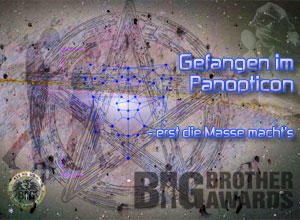

|
search / subscribe / upload / contact |
|
|
||
|
|
||
|
|
||
|
|
||
|
|
||
|
|
||
|
|
||
|
|
||
| RSS-Feed Depeschen | ||

|
||
Date: 2001-06-11
US: Untergang eines Cypherpunks-.-. --.- -.-. --.- -.-. --.- -.-. --.- -.-. --.- -.-. --.- erbarmungslose Verknackung hat es im April irgendwie nicht bis in die europäische Netz-Öffentlichkeit geschafft. Natürlich: Bell hat es wissen wollen. Man schreibt nicht ein Buch über "assassination politics" bezogen auf korrupte Staatsbeamte, provoziert Lurkers von der Polizei auf der Cypherpunk-Mailing-List, veröffentlicht Namen und Daten von Beamten des FBI und der Steuerfahndung im Netz und sucht diese Personen dann auch noch persönlich auf. In diesem unbedingt lesenswerten Essay von Deborah Natsios geht es über das Ziehen neuer Verteidigungslinien zur nationalen Sicherheit quer durch die zivie Infrastruktur der Kommunikation und um den Untergang eines Menschen, der sich nicht beugen wollte. Der aggressiv und öffentlich in die Privatsphäre der Staatsvertreter einegdrungen ist - ebenso wie es die Staatsvertreter, allerdings heimlich, mit der Privatsphäre der Bürger halten. -.-. --.- -.-. --.- -.-. --.- -.-. --.- -.-. --.- -.-. --.- relayed by John Young <jya@pipeline.com> -.-. --.- -.-. --.- -.-. --.- -.-. --.- -.-. --.- -.-. --.- Homeland Defense and the Prosecution of Jim Bell An essay by Cryptome's partner: An essay on cultural and homeland design in the USA which traces the rise of the national security mindset and the lucrative wasteland it has caused, not least by degrading higher education: -.-. --.- -.-. --.- -.-. --.- -.-. --.- -.-. --.- -.-. --.- "So, say goodnight to Joshua ..." Homeland Defense and the Prosecution of Jim Bell Deborah Natsios Cartome 8 June 2001 A sparsely attended trial which unfolded in Tacomas US district courthouse the first week of April 2001 hardly seemed an event that might open a small but revealing view onto the shifting national security apparatus. But to outside observers following the criminal prosecution of Washington State resident Jim Bell, accused of stalking and intimidating local agents of the IRS, Treasury Department and BATF, the defendant was a symptomatic target, and the governments stated case against him only a fragment of a more complex campaign linked to the evolving landscape of national and homeland defense. In the governments estimation, Bell had placed its Pacific Northwest agents "in reasonable fear of death or serious bodily injury"1. But for some trial-watchers, the case against James Dalton Bell, 43, was underpinned by a constellation of factors that made him more than the disaffected neighbor projecting antigovernment bile. Bell had invited the governments fullest prosecutorial zeal because his technical skills placed him in more ambiguous terrain, that of untested gray zones within emerging national defense landscapes, which, by calling into question the impregnability of the national border, have been taking national security tactics incountry in unprecedented ways, deploying new rules of engagement to challenge national security threats within the US domestic interior. Full Text http://cartome.org/homeland.htm (72KB) -.-. --.- -.-. --.- -.-. --.- -.-. --.- -.-. --.- - -.-. --.- -.-. --.- -.-. --.- -.-. --.- -.-. --.- -.-. --.- edited by published on: 2001-06-11 comments to office@quintessenz.at subscribe Newsletter - -.-. --.- -.-. --.- -.-. --.- -.-. --.- -.-. --.- -.-. --.- |
|
|
|
| CURRENTLY RUNNING | |
q/Talk 1.Juli: The Danger of Software Users Don't Control

|
|
| !WATCH OUT! | |
bits4free 14.Juli 2011: OpenStreetMap Erfinder Steve Coast live in Wien

|
|

